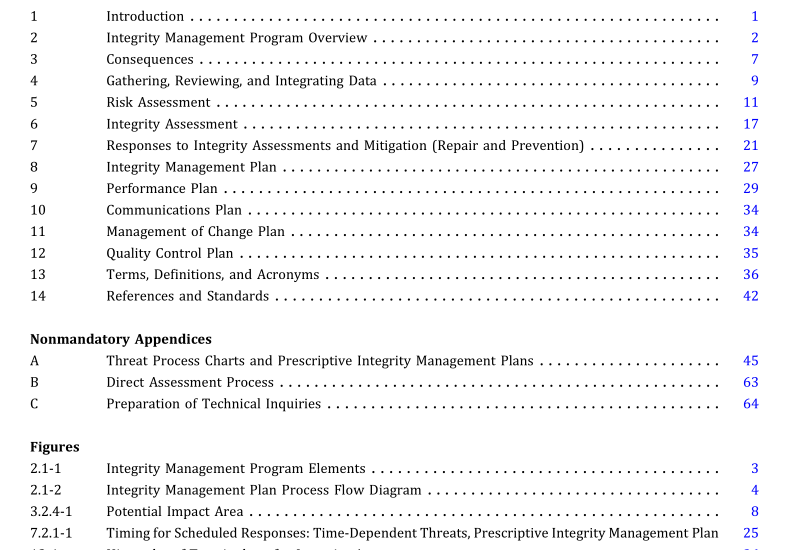ASME B31.8S:2016 pdf download Managing System Integrity of Gas Pipelines ASME Code for Pressure Piping, B31 Supplement to ASME B31.8
1 INTRODUCTION
1.1 Scope
This Code applies to onshore pipeline systems constructed with ferrous materials and that transport gas. The principles and processes embodied in integrity management are applicable to all pipeline systems. This Code is specifically designed to provide the operator (as defined in section 13) with the information necessaryto develop and implementan effective integrity managementprogram utilizing proven industry practices and processes. The processes and approaches described within this Code are applicable to the entire pipeline.
1.2 Purpose and Objectives Managing the integrity of a gas pipeline system is the primarygoalofeverypipeline systemoperator. Operators want to continue providing safe and reliable delivery of natural gas to their customers without adverse effects on employees, the public, customers, or the environment. Incident-free operation has been and continues to be the gas pipeline industry’s goal. The use of this Code as a supplement to the ASME B31.8 Code will allow pipe- line operators to move closer to that goal. A comprehensive, systematic, and integrated integrity managementprogram provides the means to improve the safety ofpipeline systems. Such an integrity management programprovidestheinformationforanoperatortoeffec- tively allocate resources for appropriate prevention, detection, and mitigation activities that will result in improved safety and a reduction in the number of incidents.
ThisCodedescribesaprocessthatanoperatorofapipeline system can use to assess and mitigate risks in orderto reduce both the likelihood and consequences ofincidents. It covers both a prescriptive-based and a performancebased integrity management program. The prescriptive process, when followed explicitly, will provide all the inspection, prevention, detection, and miti- gation activities necessaryto produce a satisfactoryinteg- rity management program. This does not preclude conformance with the requirements of ASME B31.8. The performance-based integrity management program alternative utilizes more data and more extensive risk analyses, which enables the operator to achieve a greater degree of flexibility in order to meet or exceed the requirements of this Code specifically in the areas ofinspection intervals, tools used, and mitigation techniques employed. An operator cannot proceed with the performance-based integrity program until adequate inspections are performed that provide the information on the pipeline condition required by the prescriptive- based program.
The level of assurance of a perfor- mance-based program or an alternative international standard must meet or exceed that of a prescriptive program. The requirements for prescriptive-based and perfor- mance-based integrity management programs are provided in each ofthe sections in this Code. In addition, Nonmandatory Appendix A provides specific activities by threat categories that an operator shall follow in order to produce a satisfactoryprescriptive integritymanagement program. This Code is intended for use by individuals and teams charged with planning, implementing, and improving a pipeline integrity management program. Typically, a team will include managers, engineers, operating personnel, technicians, and/or specialists with specific expertise in prevention, detection, and mitigation activities.
1.3 Integrity Management Principles A setofprinciples is the basis for the intentand specific details ofthis Code.
They are enumerated here so thatthe userofthis Code can understand the breadth and depth to which integrity shall be an integral and continuing partof the safe operation of a pipeline system. Functional requirements for integrity management shall be engineered into new pipeline systems from initial planning, design, material selection, and construc- tion. Integritymanagementofa pipeline starts with sound design, material selection, and construction of the pipeline. Guidance for these activities is primarily provided in ASME B31.8. There are also a number ofconsensus stan- dards that may be used, as well as pipeline jurisdictional safety regulations. If a new line is to become a part of an integrity management program, the functional require- ments for the line, including prevention, detection, and mitigation activities, shall be considered in order to meet this Code.
Complete records of material, design, and construction for the pipeline are essential for the initiation of a good integrity management program. System integrity requires commitment by all operating personnel using comprehensive, systematic, and inte- grated processes to safely operate and maintain pipeline systems. In order to have an effective integrity manage- ment program, the program shall address the operator’s organization, processes, and the physical system. Anintegritymanagementprogramiscontinuouslyevolving and must be flexible. An integrity management program should be customized to meet each operator’s unique conditions. The program shall be periodically
